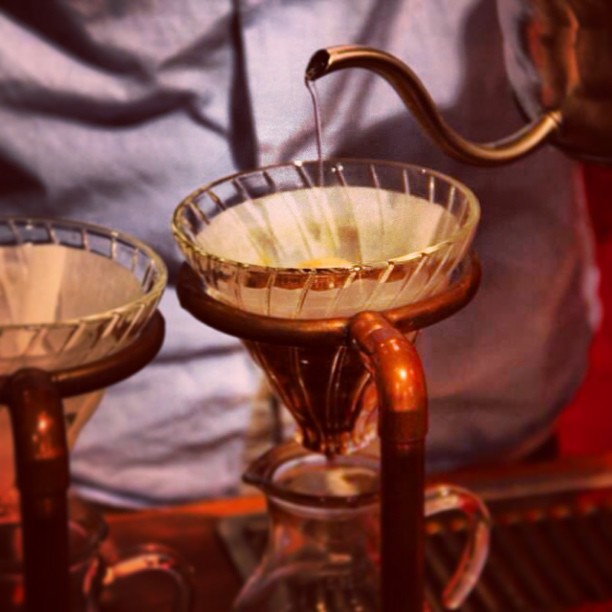A comprehensive introduction to all aspects of coffee-coffee beginners must see the knowledge.

Linnaeus classified coffee plants in the Rubiaceae family, e.g. Gardenia. The great naturalist named it Coffea.
Although plants in the wild can grow to 10-12 metres tall, those in plantations are about 3 - 5 metres tall, except in Colombia, where few species exceed 2 metres. This makes farming and picking easier and cultivation more economical.
The leaves turn dark green, light green and bronze yellow according to the stage of growth. The flowers are white, clustered and have a fragrance similar to Spanish jasmine. The flowers soon turn red berries, which vary in color depending on the type of plant.
At first glance, the fruit resembles a large cherry in size and color. This berry is enclosed in a sticky pulp (mesocarp) and covered with a thin film (exocarp). The seeds in the flesh are two bean-shaped fruits that are flat together. Each bean is wrapped in a layer of golden parchment called the endocarp.
Stripping the endocarp reveals the real bean, which is coated with another very thin silver film. The beans vary according to species, being blue-green close to bronze, up to 11 mm long and 8 mm wide. Each species has its own variety, and each variety varies in size, color and pest resistance.
species, growth
Today, some of the most important producing countries grow two major coffee varieties: Arabica and Robusta. Grafting from these two species yields several different species, denoted by the name of the country of production.
Coffea Arabica, a valuable variety, has been grown for centuries and accounts for three-quarters of the world's coffee production. As the name implies, it comes from Arabia and thrives on mineral-rich lands, with well-known subspecies being Moka, Maragogipe, San Ramon, Columnaris, and Bourbon. Arabica coffee from Brazil has the common name Brazilian Coffees; Milds from Colombia, Venezuela, Peru, Guatemala, El Salvador, Haiti and Santo Domingo. Arabica coffee is also grown in Africa. Arabica is a full-flavored coffee with a clear taste and lower caffeine content. However, due to the different types of crops, there are also different tastes. Arabica beans look lanky and pale greenish blue.
Coffea Robusta can grow to over 12 meters and up to 600 meters above sea level and grows rapidly, with greater pest resistance. Discovered in Congo in 1898, this robust variety spread widely, especially in Africa, Asia and Indonesia where the climate was not suitable for growing Coffea Arabica. It accounts for a quarter of the world's total production. Due to its higher caffeine content (about twice as high as Arabica) and its strong taste characteristics, Robustas are often used in specialized blends. Overuse and/or incorrect processing results in cheap and bitter coffee with a pronounced "woody feel" typical of African natural Robustas. The washed variety from Indonesia is rarer and more valuable in certain combinations. This bean is smaller in shape, round and yellowish brown.
Coffee crops need special natural environments to thrive and harvest well:
Suitable climate: hot and humid or sub-hot climate areas, between the north and south tropics, rainy, temperatures between 15 and 25℃.
The soil should have a deep, hard, permeable subsoil conducive to irrigation and drainage. The best land is on a hilly hillside, broken down into rocks from volcanic rocks or freshly cultivated forests. The ideal altitude is between 600 and 1200 meters, although some varieties are suitable for 2000-2200 meters, others are suitable for less than 400 meters, or even on flat ground.
Carefully cultivated with the aim of protecting the tree species at each stage of growth, therefore:
Select seeds from robust, productive and long-lived species
Seeds are first planted in sheltered, dark nurseries, and after about six months, seedlings are transplanted to plantations during the rainy season, along with the soil surrounding the roots.
Depending on the region (tropical or subtropical) in which it is grown, coffee trees are protected from high winds and excessive sunlight by other trees. Nurtured and protected in this way, trees will begin to bear fruit when they are three or four years old.
harvested and processed
Harvesting takes place in different months of the year (depending on the geographical location of the producing country), depending on the ripeness of the fruit. Harvest times depend on geographical location, climate and altitude and vary according to the individual circumstances of each producing country.
The ripe fruit can be picked by hand, or raked with a small rake, or beaten to the ground with a rod: the first two methods can be carried out with low-cost labor, which is more selective; the method of beating with a rod is faster but less delicate, and requires further cleaning of the fruit. Harvesting can be done using special automated machines, terrain conditions permitting.
Since coffee is a very delicate product, beans must be processed within a few days of harvest. This is to prevent the pulp and covering of the film fermentation. There are two ways to process seeds:
The "dry" process produces what is known as "natural" coffee; this method is mainly used in Brazil and West Africa. The fruit is spread on the ground and dried by the sun, and is constantly turned so that the fruit is evenly exposed to the sun's rays for a period of 15 to 20 days.
"Wet" treatment, which is more demanding and difficult. This process results in coffee that is called "washed" or "soft." This approach has been adopted in Central America, Mexico, Colombia, Kenya and Tanzania. The processing steps are: fruit cleaning, soaking, removing pulp, fermentation, drying and peeling, and finally removing residual impurities, and polishing the beans.
The beans are then packed into sacks, usually weighing 60 kilograms (about 132 pounds), and stored in special sheltered houses. They will begin their journey-from sacks to bags-to consumer countries.
ESPRESSO
Literally,"espresso" means "made on the spot after ordering," but when applied to coffee, it has become a noun instead of an adjective. It is a product of chemistry and physics. Specially made espresso is an emulsion of dissolved sugars, caffeine and protein, oils and colloids and suspended coffee particles and tiny bubbles. Vision (cheese-like foam or "crema" stimulates taste buds) and smell play a major role in the final judgment, with more than 600 chemicals contained in each of the different blends. Aromas and flavors are included.
A perfect espresso depends on the density of the crema (foam), which retains heat and aroma during the brief moments between making and drinking.
The best blends are made with several types of coffee from different parts of the world. Blends are specially designed for use on espresso machines and are typically medium to dark baked beans that may contain 5, 6 or more varieties of origin.
Blends of pure Arabicas-from multiple origins-taste softer and more aromatic, but blends of Arabicas and Robustas are more textured and have stronger flavors.
Although the caffeine concentration is higher (about 80-85% extracted), a good espresso contains no more caffeine than other filtered coffee because the contact time between water and coffee is shorter.
Lavazza's tasting experts have created a range of coffee blends. With their years of experience, they determined the exact proportions for each combination.
Coffee beans are packaged immediately after roasting, and the carbon dioxide generated by the roasting process (90% of the gas is generated at this stage) gradually diffuses in the remaining space of the package, and the pressure increases, which will cause the package to burst. To avoid this, a valve is glued to the bag so that carbon dioxide can escape but oxygen is prevented from entering.
Roasted coffee is perishable and should be protected from contact with light, moisture, and especially oxygen present in the air. These substances change the taste and aroma of the beans, and the essential oily components of coffee decay when they come into contact with light or oxygen. When this happens, oxidation occurs, releasing unpleasant, rancid odors that overwhelm the coffee's natural aroma.
Decaf coffee
Many of the effects coffee has on our bodily functions are primarily due to the caffeine it contains. A small cup of coffee contains 50-150 mg of this alkaloid. A scientist named Ludwig Raselius used steam to infiltrate coffee beans. Caffeine is released through porosity and can be easily extracted with organic solutions.
It should be noted that the term "decaf" is subject to strict legislation to ensure compliance with many laws. These regulations specify not only the green coffee beans but also the percentage of caffeine allowed to make coffee. Each decaffeination method must comply with European Community regulations, and caffeine in green coffee beans must be reduced to less than 0.1%.
LAVAZZA Coffee Description
PIENAROMA
100% ARABICA
An exquisite blend of 100% Arabica coffee with unique aromas and aromas.
Origins variety
100% Arabica Coffee
Body alcohol
★★★
Roasting baking degree
moderate
Distinguishing characteristic
fine
Aroma and flavor Aroma and flavor
Fragrant, aromatic, smooth, fine, slightly acidic
100% Arabicas from Brazil's finest plantations and aromatic milds from the Central American highlands give this blend unique fruit and flower aromas.
GOLD SELECTION
A delicate blend of fine coffee with a very strong flavor.
Origins
Mild washed and unwashed Arabica plus a small amount of washed Robusta coffee.
Body
★★★
Roasting
moderate
Distinguishing characteristic
smooth
Aroma and flavour
Very smooth, well balanced, with a strong aftertaste.
This blend is made with a selection of sweet Brazilian coffee, smooth Central American and high quality Asian varieties.
GRAND’ ESPRESSO
"Excellent espresso", a blend of rich and intense flavors.
Origins
A selection of washed/unwashed Robusta and Arabica coffees
Body
★★★★
Roasting
moderate
Distinguishing characteristic
strong
Aroma and flavour
Intense body, very rich and intense taste, spicy and slightly chocolatey.
Fine Arabicas from Central America and South America mixed with washed Robustas from Asia and Africa, presenting a rich texture and full flavor. This blend is especially appreciated by those who love creamy Italian espresso and has a long aftertaste.
LAVAZZA IN BLU
You can also enjoy an espresso at home.
The carefully developed 100% Arabica blend makes top-notch espresso at home. LAVAZZA IN BLU has a full flavor, Lavazza recommends that you use an electric espresso machine to make it.
A blend of 100% Arabica coffee from Brazil and South America. The smooth and rich texture is highlighted by its wonderful fragrance.
CREMA E AROMA
an aromatic coffee with a strong flavor.
Aromatic African coffee, a blend of rich Asian and sweet South American varieties. Special baking adds to its intense flavor and spicy taste.
DEK
A decaffeinated blend of rich Brazilian and sweet Asian coffee that blends aromatic and creamy coffee.
This decaf coffee has the perfect balance, with a selection of sweet Brazilian and Asian varieties. The European Commission stipulates that the caffeine standard for a cup of decaf coffee should not exceed 0.1%. Dek has a rich taste and pleasant overall aroma. A slight deep bake gives this blend good body.
Qualità Oro
This is one of Italy's most popular combinations.
Its outstanding characteristics are the balanced presentation of all the flavours of a real cup of coffee, African Robusta and Brazilian Plateau Arabica, giving this coffee its rich body, chocolate flavours and soft aromas. And this blend blends well with milk, making it the ideal coffee to go with breakfast.
Source:
Two bottles of water coffee world blog
Important Notice :
前街咖啡 FrontStreet Coffee has moved to new addredd:
FrontStreet Coffee Address: 315,Donghua East Road,GuangZhou
Tel:020 38364473
- Prev

The skills and operation sequence of coffee flower drawing are introduced to make a cup of perfect flower drawing.
Coffee flower production method 1 milking: the most important technology, although not very advanced, but requires a long time of practice, requires fine and smooth milk foam, do not have large milk bubbles. 2 milking angle: it is best to milk at an angle of 45 degrees with the steam sprinkler, depending on the thickness of the foam according to the fluctuation. Three hearts! The most basic flower drawing skills, if friends want to do. In fact, pull flowers (carved flowers)
- Next

Special and rare Coffee processing methods in the World: a brief introduction to Stone roasted Coffee
Talking about its baking mechanism, the stone roasting coffee roaster is about the same as the ordinary hot air roaster in appearance, but the internal structure is different. First of all, there is a net between the charcoal fire and the stone pot in its closed hot blast stove, which is separated by a layer of unique ore in Gifu Prefecture, Japan, and secondly, its stone pot is different from ordinary boilers, which is made of two-layer punched iron mesh, in the middle of the iron net.
Related
- What is the meaning of lactic acid fermentation with coffee bean treatment?
- How to judge the state of foam by sound?
- How does the latte pull out the unicorn pattern? Come to get for a little trick to improve the flower pull!
- Will flower pulling affect the taste of the latte?
- Do you know the history of coffee?
- The difference between honey treatment and sun washing what is raisin honey treatment?
- What kind of milk can a novice use to make coffee foam to keep the foam longer? The correct method and skills of milking tutorial sharing
- Why do washed coffee beans taste sour? Flavor characteristics of washed Coffee
- Introduction to the skill of how to practice the size and height of water injection around the circle of hand-brewed coffee
- How do beginners practice coffee flower drawing from scratch?

